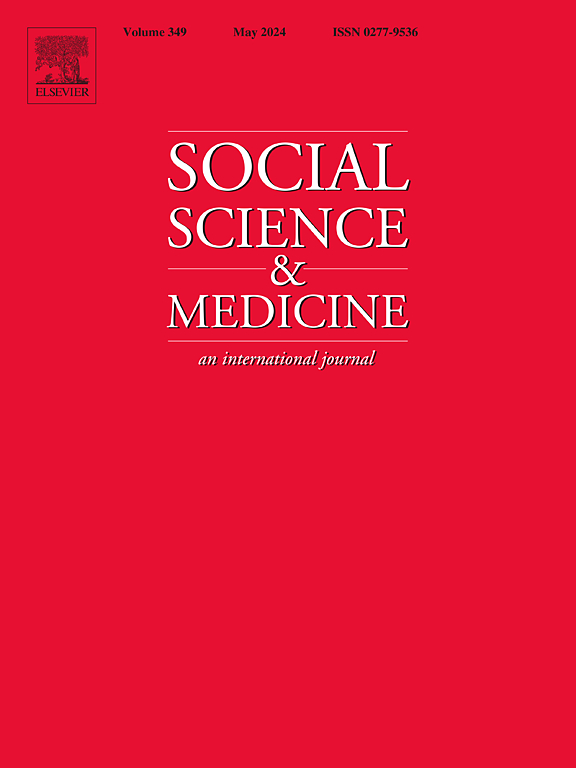Infant birth weight in Brazil: A cross-sectional historical approach
IF 4.9
2区 医学
Q1 PUBLIC, ENVIRONMENTAL & OCCUPATIONAL HEALTH
引用次数: 0
Abstract
In 1888, Brazil became the last country in the Americas to abolish slavery. Historians have outlined the racialized health disparities of people of African descent in the post-abolition period. Epidemiologists have shown that twenty-first-century health disparities continue to mirror patterns from over a century ago. This cross-sectional analysis quantifies health disparities in a post-abolition maternity hospital using infant birth weight. It relies on hospital records on infants delivered between 1922 and 1926 (n = 2845) at the Maternidade Laranjeiras in the city of Rio de Janeiro, Brazil to run linear models assessing differences in infant birth weight by maternal skin color, age, number of pregnancies (parity), and nationality. African ancestry was correlated with lower birth weights. Infants born to Afro-descendant women had birth weights estimated to be 84 g lighter (p-value = 0.002 [95% CI -137, −32]) than infants born to Euro-descendant women. Among Afro-descendant women, infants born to Black (preta) women had birth weights estimated to be 100 g lighter (p-value = 0.001 [95% CI -160, −39]) and infants born to mixed-race (parda) women had birth weights estimated to be 70 g lighter (p-value = 0.022 [95% CI -130, −10]) than infants born to White women. The findings were likely the consequence of slavery's legacy, particularly race-based socioeconomic inequality – including more strenuous work schedules, poorer nutrition, and less sanitary living environments for people of African descent. The findings are consistent with current-day research on racialized health disparities in Brazil and demonstrate the importance of historical findings to public health research.
巴西婴儿出生体重:横断面历史方法。
1888年,巴西成为美洲最后一个废除奴隶制的国家。历史学家概述了废奴后时期非洲人后裔的种族健康差异。流行病学家已经表明,21世纪的健康差距继续反映出一个多世纪前的模式。这个横断面分析量化在废除后的妇产医院使用婴儿出生体重的健康差距。该研究依靠巴西里约热内卢市Maternidade Laranjeiras医院1922年至1926年间出生的婴儿(n = 2845)的医院记录,运行线性模型,评估婴儿出生体重在母亲肤色、年龄、怀孕次数(胎次)和国籍方面的差异。非洲血统与较低的出生体重相关。非洲裔女性所生婴儿的出生体重估计比欧洲裔女性所生婴儿轻84克(p值= 0.002 [95% CI -137, -32])。在非洲裔妇女中,黑人(preta)妇女所生婴儿的出生体重估计比白人妇女所生婴儿轻100克(p值= 0.001 [95% CI -160, -39]),混血儿(parda)妇女所生婴儿的出生体重估计比白人妇女所生婴儿轻70克(p值= 0.022 [95% CI -130, -10])。这些发现很可能是奴隶制遗留问题的结果,尤其是基于种族的社会经济不平等——包括对非洲人后裔来说,更繁重的工作时间表、更差的营养和更不卫生的生活环境。这些发现与目前巴西种族化健康差异的研究结果一致,并表明了历史发现对公共卫生研究的重要性。
本文章由计算机程序翻译,如有差异,请以英文原文为准。
求助全文
约1分钟内获得全文
求助全文
来源期刊

Social Science & Medicine
PUBLIC, ENVIRONMENTAL & OCCUPATIONAL HEALTH-
CiteScore
9.10
自引率
5.60%
发文量
762
审稿时长
38 days
期刊介绍:
Social Science & Medicine provides an international and interdisciplinary forum for the dissemination of social science research on health. We publish original research articles (both empirical and theoretical), reviews, position papers and commentaries on health issues, to inform current research, policy and practice in all areas of common interest to social scientists, health practitioners, and policy makers. The journal publishes material relevant to any aspect of health from a wide range of social science disciplines (anthropology, economics, epidemiology, geography, policy, psychology, and sociology), and material relevant to the social sciences from any of the professions concerned with physical and mental health, health care, clinical practice, and health policy and organization. We encourage material which is of general interest to an international readership.
 求助内容:
求助内容: 应助结果提醒方式:
应助结果提醒方式:


